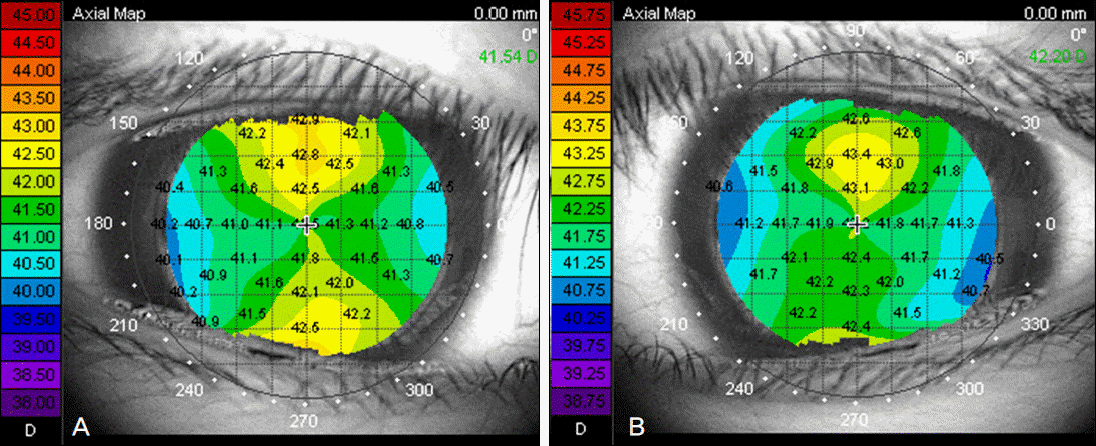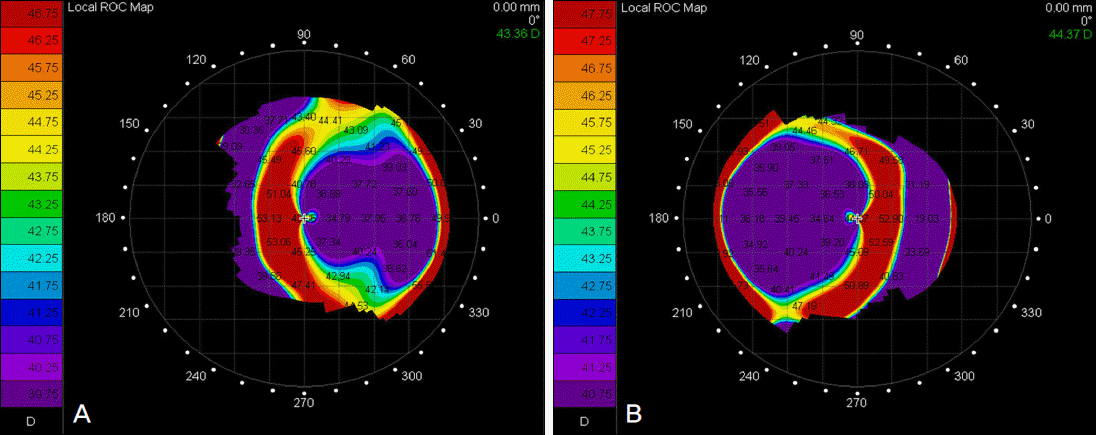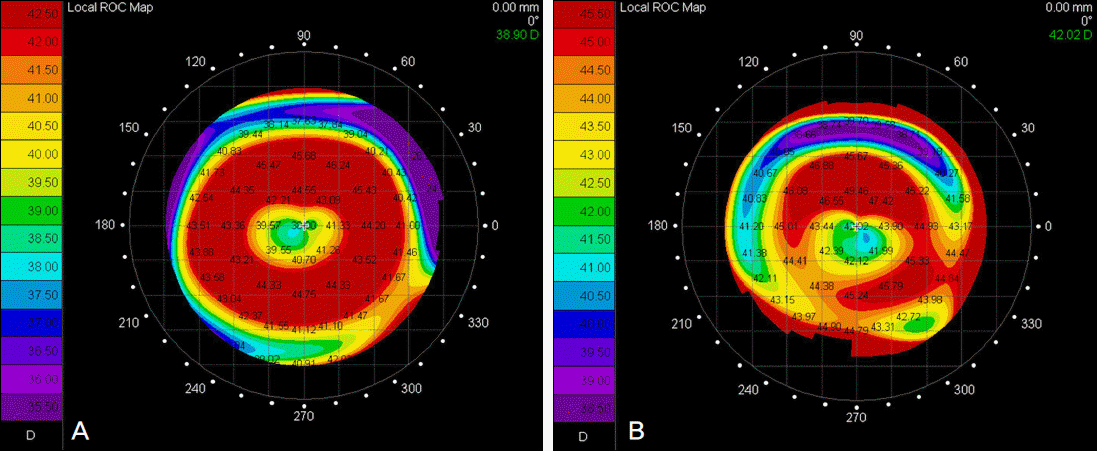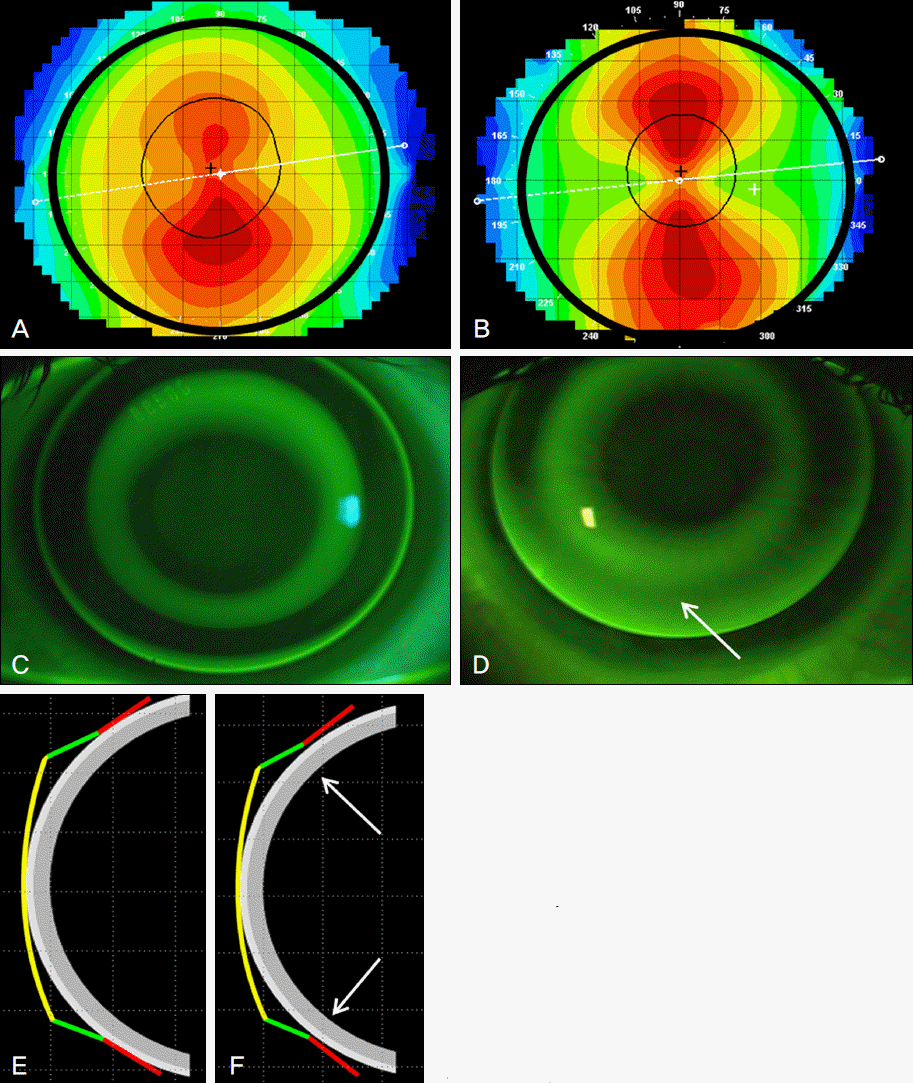Abstract
Purpose
To report the efficacy of toric orthokeratology lenses in a patient with corneal astigmatism within 1.5 D having difficulty wearing spherical orthokeratology lenses because of limbus-to-limbus corneal astigmatism
Case summary
An 11-year-old boy who wanted to wear orthokeratology lenses had a refractive error of -4.75 D sph = -1.00 D cyl 180 in the right eye and -4.50 D sph = -1.25 D cyl 180 in the left eye. The corneal astigmatism was 1.19 D and 1.19 D, respectively, and limbus-to-limbus corneal astigmatism was observed in topography. After wearing spherical orthokeratology lenses, the patient complained of monocular diplopia and both lenses were found to be displaced nasally. Toric orthokeratology lenses were prescribed for centration of lenses and resulted in significant improvement of uncorrected visual acuity of 20/20, refractive error of +0.75 D sph = -0.50 D cyl 170 in the right eye and +0.50 D sph = -0.50 D cyl 160 in the left eye, and centration of lenses for the 12-month follow-up period.
References
1. Cho P, Cheung SW, Edwards M. The longitudinal orthokeratology research in children (LORIC) in Hong Kong: a pilot study on refractive changes and myopic control. Curr Eye Res. 2005; 30:71–80.

2. Lee WH, Park YK, Seo JM, Shin JH. The inhibitory effect of myopic and astigmatic progression by orthokeratology lens. J Korean Ophthalmol Soc. 2011; 52:1269–74.

3. Chan B, Cho P, Cheung SW. Orthokeratology practice in children in a university clinic in Hong Kong. Clin Exp Optom. 2008; 91:453–60.

4. Mountford J, Pesudovs K. An analysis of the astigmatic changes induced by accelerated orthokeratology. Clin Exp Optom. 2002; 85:284–93.

5. Sanders DR, Koch DD. An atlas of corneal topography, 1st ed. New Jersey: Slack Incorporated;1993. p. 5563.
6. Pauné J, Cardona G, Quevedo L. Toric double tear reservoir contact lens in orthokeratology for astigmatism. Eye Contact Lens. 2012; 38:245–51.

7. Chen CC, Cheung SW, Cho P. Toric orthokeratology for highly astigmatic children. Optom Vis Sci. 2012; 89:849–55.

Figure 1.
Prefitting topography shows limbus-to-limbus with-the-rule corneal astigmatism (A: right eye, B: left eye).

Figure 2.
After 1 month of wearing spherical orthokeratology lens, both eyes (A: right eye, B: left eye) show nasally flattened cornea on topography.

Figure 3.
After 12 months of wearing toric orthokeratology lenses, both eyes (A: right eye, B: left eye) show well-centered bull's eye pattern on topography.

Figure 4.
Topography (A, B), fluorescein stain (C, D), and schematic structure (E, F) of eyes with central (A, C, E) and limbus-to-limbus (B, D, F) corneal astigmatism fitted with spherical orthokeratology lens. Arrows show the steep fitting of alignment curves (red colors) along with astigmatic axis in eye with limbus to limbus astigmatism (yellow colors; optic zone, green colors; reverse curves).

Table 1.
The calculation of sagittal height difference of patient's right eye by the excel sheet. If the value of keratometric reading, eccentricity, and half chord area of flat and steep meridian are inserted, the value of p, R0, corneal sagittal height, and sagittal height difference are automatically calculated by the excel sheet





 PDF
PDF ePub
ePub Citation
Citation Print
Print


 XML Download
XML Download